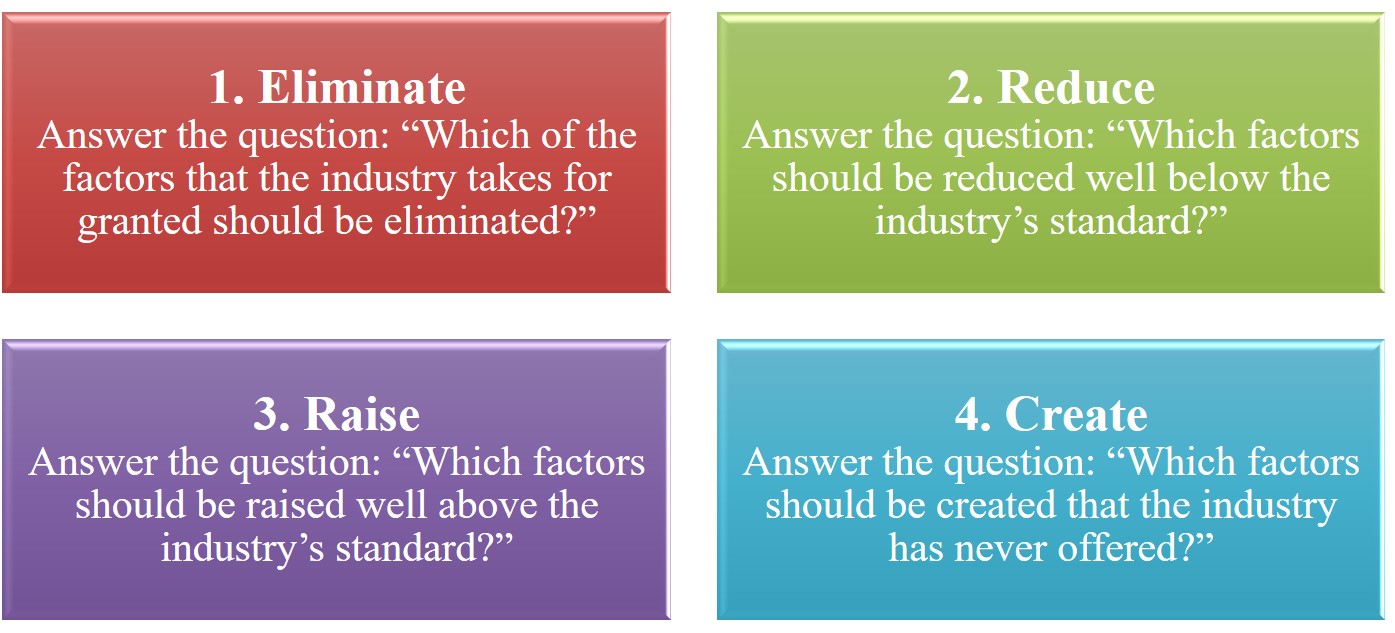1. Analytical tools of blue ocean strategy
Kim and Mauborgne (2005) have developed three tools allowing firms to develop their blue ocean strategy. Specifically:
1.1. Strategic Canvas
Strategic canvas, the most basic analytical tool, throughout the blue ocean strategy, is an image that includes value line of a firm and that of its competitors. Value here is understood as interests and expectations of customers. The value line is represented on a coordinate axis consisting of horizontal axis (Ox) of evaluating industry competitiveness; and vertical axis (Oy) of evaluating high or low level of value that firms bring to their customers. Through market research, firms can assess the competitiveness of products compared to that of their competitors. A value line is a line that folds through the points representing the value that a firm’s products bring to customers located on the coordinate axis.
Figure 1: The Strategy canvas of car

Source: Kim and Mauborgne (2005)
The Strategic canvas explain what its competitors of the firm are as well as what competition factors firm should be focused on. If its value line is different from that of the competitors, the firm has succeeded in creating a “blue ocean” in the market. In contrast, if the firm’s value line is similar to the one of competitors, it means that the firm is in the “red ocean”; so, it is necessary to “curve” the value line to create a new blue ocean.
1.2. The Four Forces Frame
After positioning the business situation through a strategic canvas, the next step of firm managers is to redraw the value line of the firm for achieving both the low cost and differentiation goals. To do this, the firm needs to cut down the factors that are not important by increasing the ones that bring higher value to customers. This is the core of the blue ocean strategy. During the implementation process, the firm needs to answer four big questions, called The Four Forces Frame, as shown below:
Figure 2: The Four Actions Framework of Blue Ocean Strategy

Source: Kim and Mauborgne (2005)
Answering the first two questions allow firms to find a more effective way to cut down its costs than that of the competitors. The next two questions allow firms to identify which factors strengthen customers’ benefit. Excess resources, resulting from the first two questions, will be used to invest in other factors, that firm deems more necessary in the remaining two questions for greater performance and greater benefits to customers.
1.3. The Elimination – Reduction – Improvement – Creation Net
The Elimination – Reduction – Improvement – Creation Net is an analytical tool that complements the Four Forces Frame. After answering four questions in the frame, firms fill the answers in the net model.
Figure 3: Eliminate-Reduce-Raise-Create Grid

Source: Kim and Mauborgne (2005)
Filling in the net model allows firms to see what they should to do for creating a blue ocean strategy. Firms need to consider the equal importance of actions. This model also warns firms not to just focus on growth and branding, because these factors easily increase the cost structure and often makes the function of products and services redundant in comparison to those of customer requirements. Instead, firms should pay attention to the factors of elimination and reduction.
2. Six principles of formulating and executing blue ocean strategy
There are six principles of formulating and executing blue ocean strategy, associated with different types of risks. Specifically summarized in the table below:
Table 1: The Six Principles of Blue Ocean Strategy

Source: Kim and Mauborgne (2005)
There are four basic and relatively independent principles that allow firms to successfully formulate a blue ocean strategy, including:
- Principle 1: Reconstruct market boundaries
The first principle of blue ocean strategy is to destroy the old market boundaries and redraw the new ones of the blue ocean. To reconstruct market boundaries by minimizing risks in the search process, firms can apply one or several or all of the following 6 paths: (1) look across alternative industries; (2) look across strategic groups within industries; (3) look across the chain of buyers; (4) look across complementary product and service offerings; (5) look across functional or emotional appeal to buyers; (6) look across time.
- Principle 2: Focus on the big picture, not the numbers
After understanding the basic way to break the boundaries of red ocean, firms need to research the market carefully to make a specific action plan. The second principle requires firms to use an analysis tool “strategic canvas”. By sticking to the “strategic canvas”, firms can take consistent action for the set goals and avoid confusion.
- Principle 3: Reach beyond existing demand
There are two common ways to implement a competitive strategy that the firms immersed in the red ocean using. Firstly, they compete by capturing customer preferences in smaller market segments. Secondly, instead of focusing on customers, they pay attention to those who have not purchased. Instead of focusing on the differences between customers, they need to explore the similarities in customer value assessments. That allows them to go beyond current needs to reach new customers, who are actually non-customers can offer firms the opportunity to open a new blue ocean.
- Principle 4: Get the strategic sequence right
The right strategic sequence ensures that both firms and customers benefit when the blue ocean strategy is formulated. In which, products allow high satisfaction to customers; and customers can buy products at appropriate prices and firms are profitable. The right strategic sequence consists of four steps, namely: (1) determine exceptional buyer utility in business idea; (2) determine price easily accessible to the mass of buyers; (3) determine costs to profit at strategic price; (4) determine the adoption hurdles in actualizing business idea (see Appendix for details).
Once the blue ocean strategy has been formulated, firms should quickly follow the next two principles of executing blue ocean strategy:
- Principle 5: Overcome key organizational hurdles
The organizational hurdles that firms face when executing the blue ocean strategy are often: cognitive, limited resources, motivation, and politics (opposition from powerful vested interests).
- Principle 6: Build execution into strategy
Principle 6 of building a 3E management process includes engagement, explanation, and clarity of expectation, which allows firms to effectively manage the blue ocean strategy. This management process must be applied to all employees from senior to lowest level. The 3E management process has positive impact on the psychology and behaviors of employees. They will feel their opinions are valued, thereby will complete work beyond the requirements of obligations, by gradually taking initiative in creativity at work.

10 Sep 2019